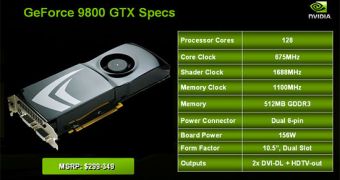Graphics expert Nvidia is gearing up for the introduction of its new GeForce 9800GTX graphics card slated to kick in on March 25. It will be accompanied by a few other new Nvidia graphics cards in the GeForce 9800 series, such as the dual-chip GeForce 9800 GX2 behemoth that will be introduced in just four days.
The single-chip 9800 GTX will replace the GeForce 8800 GTX, as the 65-nanometer graphics core supports three-way SLI technology. The card's alleged technical specifications have been neither confirmed, nor denied by Nvidia, as part of its incapacity to comment on rumors.
However, recently leaked slides from the GeForce 9800 GTX presentation did all the company's work on confirming the card's specifications. According to the slides, the stock cards will come with GPU core frequencies of 675MHz, while the 128 shader processors will be clocked at 1688MHz. It will also come with 512 MB of GDDR3 memory clocked at 1100 MHz.
The GeForce 9800 GTX will be powered externally, via a 6-pin power connector, that is alleged to sustain its 156 watts peak power consumption. The stock card will feature two Dual-Link DVI outputs and one HDMI connector. There is no DisplayPort interface available, but its implementation will depend on each of Nvidia's manufacturing partners.
The card will aim at the mid-range graphics market and will sell at estimative retail prices of between $299 and $349. It will replace the previous GeForce 8800 GTX, while the dual-chip geForce 9800 GX2 will substitute for the high-end GeForce 8800 Ultra. However, the same slides show that the GeForce 8800 GTS 512MB will not be replaced by a newer offering, at least not until the end of the first quarter.
Given the fact that the GeForce 9800 GTX comes with full support for Tri-SLI technology, the slides also outlined the way the new graphics card will scale. For instance, installing a second graphics card would boost the graphics performance with between 70 and 90 percent, while the third GPU would usually push the limits to 150 percent performance gains.

 14 DAY TRIAL //
14 DAY TRIAL //